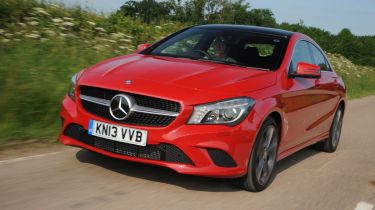Mercedes CLA 220 CDI Sport
New compact four-door coupe looks to replicate the sales success of the larger CLS
It’s close but no cigar for the CLA. If you love how it looks and don’t mind shelling out for hi-tech gadgets, it’s a great choice. But you’ll have to put up with a cramped interior (especially in the back), an awkwardly shaped boot and a compromised driving experience. We recommend avoiding the run-flat tyres if you want a semblance of comfort.
When the new Mercedes A-Class was launched late last year, it ditched the upright mini-MPV shape of the original car in favour of a stylish hatchback body. The new CLA builds on that, taking the A-Class’ front end and adding a curving, coupé-like roofline that tapers back to a saloon tail.
Styling is always a matter of opinion, but the CLA does look awkward compared to the VW. From the base of the windscreen forwards, the nose is the same as the A-Class’, with a big grille and prominent three-pointed star.
Yet the front end looks higher than the rear, which gives the car a nose-up profile, while the whole body could do with being lowered a few millimetres for a sportier stance. At the rear, the styling looks a little bit fussy, while the gaping shut line around the bootlid on our car seemed at odds with Merc’s reputation for excellent build quality.
Used - available now

2023 Peugeot
3008
27,941 milesAutomaticDiesel1.5L
Cash £18,497
2022 BMW
X1
46,719 milesAutomaticDiesel2.0L
Cash £18,097
2020 Hyundai
Ioniq hybrid
45,952 milesAutomaticPetrol1.6L
Cash £12,497
2022 Volkswagen
e-Up
22,485 milesAutomaticElectric
Cash £10,597Climb inside and things improve. The dashboard is the same as the A-Class’, so you get a smart look that is more modern than the CC’s. But the quality of the finish isn’t up to the same standard, with flimsy air vents and squeaks and rattles.
The tablet-style screen on the centre console looks like an afterthought, but the display is clear and easy to use, thanks to the control wheel next to the driver’s seat. Our car came with the £2,100 optional COMAND Online multimedia system, which replaces the standard 5.8-inch display with a seven-inch one.
Plus, there are several large storage cubbies lower down on the console and a big bin under the centre armrest, so there’s plenty of space for odds and ends.
The CLA’s standard sports seats are comfortable and supportive, but they’re also quite large, so they cut into legroom in the back. Add a low roofline that comes close to your head, and the rear isn’t the most inviting place to sit. The middle seat in particular is quite narrow, too. And getting in and out of the back is harder than in the larger CC, as it’s very easy to hit your head on the low door frame.
The smaller dimensions mean the CLA isn’t quite as roomy as the CC inside, but its boot is 18 litres larger, with a capacity of 470 litres. However, the boot opening is narrow, and while the back seats split and fold, you can only operate them with releases on the shoulders of the seatbacks – there are no releases in the boot itself. And while there’s some under-floor storage, it’s shallow.
Under the bonnet, the 220 CDI’s 2.1-litre diesel is quite rattly at idle, and it’s noisier than the CC’s engine once you’re up and running. Performance is impressive, though: the Merc was faster than the CC in all our acceleration tests, recording a 30-70mph time of 7.3 seconds – a second faster.
Throttle response did seem a bit sluggish – even in Sport mode – but the seven-speed gearbox delivered smooth shifts whether we used the steering wheel-mounted paddles or let the transmission take control.
While the CLA is quick in a straight line, the rest of the dynamic package is a letdown. There’s good grip in corners, and steering is progressive and well weighted. However, the suspension set-up is too stiff, causing the car to occasionally hop and skip over mid-corner bumps.
Our model had optional run-flat tyres, and their stiff sidewalls make the ride even worse, causing the car to crash into potholes, shaking the whole cabin. In contrast, the CC’s adaptive dampers allow it to shrug off bumps, even when it’s in the stiffest Sport setting.
As with the dynamics, the CLA’s financial package is a bit of a mixed bag. At £29,355, the 220 CDI Sport costs £1,240 less than the CC tested here. But equipment such as heated leather seats, xenon lights and a DAB radio – all standard on the Volkswagen – willadd a further £4,000 to that figure.
If you can spare these luxuries, the Merc’s lower tax bill for both private and company buyers is tempting. Plus, the new car will lose less value over three years. So can this make up for its shortcomings in other areas?







